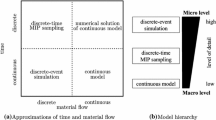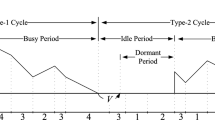Abstract
In this study, a Markovian fluid flow system with two stages separated by a finite buffer is considered. Fluid flow models have been analyzed extensively to evaluate the performance of production, computer, and telecommunication systems. Recently, we developed a methodology to analyze general Markovian continuous flow systems with a finite buffer. The flexibility of this methodology allows us to analyze a wide range of systems by specifying the transition rates and the flow rates associated with each state of each stage. In this study, in order to demonstrate the applicability of our methodology, we model and analyze a range of models studied in the literature. The examples we analyze as special cases of our general model include systems with phase-type failure and repair-time distributions, systems with machines that have multiple up and down states, and systems with multiple unreliable machines in series or parallel in each stage. For each case, the Markovian model is developed, the transition and flow rates are determined, and representative numerical results are obtained by using our methodology.
Similar content being viewed by others
References
Ahn, S., & Ramaswami, V. (2003). Fluid flow models and queues: a connection by stochastic coupling. Stochastic Models, 19(3), 325–348.
Ahn, S., Jeon, J., & Ramaswami, V. (2005). Steady state analysis for finite fluid flow models using finite QBDs. Queueing Systems, 49, 223–259.
Anick, D., Mitra, D., & Sondhi, M. (1982). Stochastic theory of a data handling system with multiple sources. Bell System Technology Journal, 61, 1871–1894.
Bihan, H. L., & Dallery, Y. (2000). A robust decomposition method for the analysis of production lines with unreliable machines and finite buffers. Annals of Operations Research, 93, 265–297.
Dallery, Y., & Bihan, H. L. (1999). An improved decomposition method for the analysis of production lines with unreliable machines and finite buffers. International Journal of Production Research, 37(5), 1093–1117.
Diamantidis, A., Papadopoulos, C., & Vidalis, M. (2004). Exact analysis of a discrete material three-station one-buffer merge system with unreliable machines. International Journal of Production Research, 42(4), 651–675.
Dubois, D., & Forestier, J. P. (1982). Productivité et en-cours moyens d’un ensemble de deux machines séparées par une zone de stockage. RAIRO Automatique, 16, 105–132.
Elwalid, A., & Mitra, D. (1991). Analysis and design of rate-based congestion control of high speed networks, i: stochastic fluid models, access regulation. Queueing Systems Theory Applications, 9, 19–64.
Forestier, J. (1980). Modelisation stochastique et comportement asymptotique d’un systeme automatise de production. RAIRO Automatique, 14(2), 127–143.
Gershwin, S. B., & Schick, I. C. (1980). Continuous model of an unreliable two-machine material flow system with a finite interstage buffer. Report LIDS-R-1039, MIT Laboratory for Information and Decision Systems.
Helber, S., & Jusic, H. (2004). A new decomposition approach for non-cyclic continuous material flow lines with a merging flow of material. Annals of Operations Research, 125, 117–139.
Kim, J., & Gershwin, S. B. (2005). Integrated quality and quantity modeling of a production line. OR Spectrum, 2, 287–314.
Koster, M. B. M. D. (1989). Capacity oriented analysis and design of production systems. Berlin: Springer.
Levantesi, R., Matta, A., & Tolio, T. (2003). Performance evaluation of continuous production lines with machines having different processing times and multiple failure modes. Performance Evaluation, 51, 247–268.
Mandjes, M., Mitra, D., & Scheinhardt, W. (2003). Models of network access using feedback fluid queues. Queueing Systems, 44, 365–398.
Mitra, D. (1988). Stochastic theory of a fluid model of multiple failure-susceptible producers and consumers coupled by a buffer. Advances in Applied Probability, 20, 646–676.
Özdoğru, U., & Altıok, T. (2003). Analysis of two-valve fluid flow systems with general repair times. In Analysis and modeling of manufacturing systems (pp. 255–288). Dordrecht: Kluwer Academic.
Poffe, A., & Gershwin, S. (2005). Integrating quality and quantity modelling in a production line. Technical Report ORC-377-05, Massachusetts Institute of Technology Operations Research Center Working Paper Series.
Serucola, B. (2001). A finite buffer fluid queue driven by a Markovian queue. Queueing Systems, 38, 213–220.
Sevast’Yanov, B. (1962). Infuence of stage bin capacity on the average standstill time of a production line. Theory of Probability and Its Applications, 7(4), 429–438.
Soares, A. D. S., & Latouche, G. (2006). Matrix-analytic methods for fluid queues with finite buffers. Performance Evaluation, 63, 295–314.
Tan, B. (2001). A three station continuous materials flow merge system with unreliable stations and a shared buffer. Mathematical and Computer Modelling, 33(8–9), 1011–1026.
Tan, B., & Gershwin, S. B. (2007). Modelling and analysis of Markovian continuous flow production systems with a finite buffer: A general methodology and applications. Technical Report ORC-381-07, Massachusetts Institute of Technology Operations Research Center Working Paper Series.
Tan, B., & Gershwin, S. B. (2009). Analysis of a general Markovian two-stage continuous flow production system with a finite buffer. International Journal of Production Research, 120(2), 327–339.
Wijngaard, J. (1979). The effect of interstage buffer storage on the output of two unreliable production units in series with different production rates. AIIE Transactions, 11(1), 42–47.
Yeralan, S., & Tan, B. (1997). A station model for continuous materials flow production. International Journal of Production Research, 35(9), 2525–2541.
Yeralan, S., Franck, W., & Quasem, M. A. (1986). A continuous materials flow production line model with station breakdown. European Journal of Operational Research, 27, 289–300.
Author information
Authors and Affiliations
Corresponding author
Rights and permissions
About this article
Cite this article
Tan, B., Gershwin, S.B. Modelling and analysis of Markovian continuous flow systems with a finite buffer. Ann Oper Res 182, 5–30 (2011). https://doi.org/10.1007/s10479-009-0612-6
Received:
Accepted:
Published:
Issue Date:
DOI: https://doi.org/10.1007/s10479-009-0612-6




